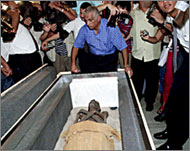Egypt to X-ray King Tut’s mummy
Egypt plans to X-ray the mummy of Tutankhamun to find out what killed the king who ruled Egypt more than 3000 years ago and died in his teens.

Archaeologists will move Tutankhamun’s body from its tomb, which was discovered packed with treasures in 1922, to Cairo for tests which should resolve the question of whether he died naturally or was murdered.
“We will know about any diseases he had, any kind of injuries and his real age,” Egyptian antiquities chief Zahi Hawass said.
“We will know the answer to whether he died normally or was he killed.”
The mummy would be moved by the end of November and the CAT scan, which will produce a three-dimensional X-ray of his remains, will be completed by the end of the year, Hawass said.
Treasures
Tutankhamun’s treasures, including a stunning gold mask which covered the head of his mummy, were removed from the tomb in Luxor’s Valley of the Kings by British archaeologist Howard Carter. They are usually on show in the Cairo museum.
 |
|
The mummy of King Ramses I was |
But his mummified remains were left in the tomb in a stone coffin. Archaeologists last opened the coffin in 1968, when an X-ray revealed a chip of bone in his skull.
That fuelled speculation that a blow to the head had killed the king, with his high priest and army commander singled out as chief suspects.
“No one has seen the mummy since 1968,” Hawass said.
X-ray
The three-dimensional X-ray of what appears to be a fracture would show whether it had been caused by a blow to the head, said Brando Quilici, a film maker with National Geographic, which is partly sponsoring the research.
Hawass said Tutankhamun’s mummy had largely been smashed to pieces by Carter’s expedition, when tools were used to remove the king’s gold mask from his body. The mask had been firmly attached to the mummy by resin, he said.
But that would not hinder the research.
|
“We will know about any diseases he had, any kind of injuries and his real age” Zahi Hawass |
“Even if it’s just bone, we can examine each bone,” he said.
Mystery has surrounded Tutankhamun since the discovery of his tomb. Lord Carnarvon, Carter’s sponsor and among the first to enter the tomb, died shortly afterwards from an infected mosquito bite.
Newspapers at the time said Carter had unleashed a pharaonic curse which killed Carnarvon and others linked to the discovery.
Scientists have in the past suggested that a disease lying dormant in the tomb may have killed the British aristocrat.